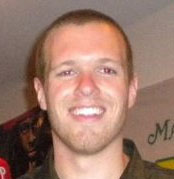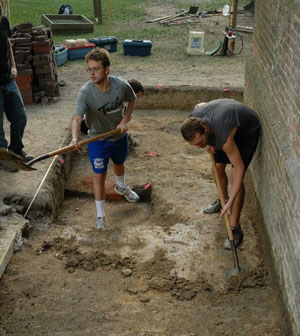Evan Rutherford '13 uncovers new passion at field school
Related Links:
- Pamunkey Perspective: Teaching Assistant Ashley Atkins
- Uncovering Field School: Session Two
- Pre-excavation: Brafferton Indian Ceremony
- Learn More: The Brafferton Project
 “It’s not every day you get to dig up an Indian school from the 1800s,” says Evan Rutherford '13. That’s one reason he jumped at the opportunity to join the College’s Archaeological Field School this summer—a decision that’s changed his future academic plans.
“It’s not every day you get to dig up an Indian school from the 1800s,” says Evan Rutherford '13. That’s one reason he jumped at the opportunity to join the College’s Archaeological Field School this summer—a decision that’s changed his future academic plans.
Run by the Colonial Williamsburg Foundation in conjunction with the Department of Anthropology, this year's field school was at the Brafferton and offered two five-week sessions. Originally designed to house the College’s Indian School, the historic 1723 Brafferton building is undergoing an extensive archaeological excavation prior to needed renovation and waterproofing.
Students learned excavation techniques and recording, as well as the identification of common eighteenth-century artifacts. They were introduced to archaeology’s specialties, including conservation, public archaeology, and zooarchaeology, through lectures and required reading.
“I knew I wanted to be outside rather than in a classroom during the summer, so I decided to explore the field school option,” says Evan who stayed in Williamsburg for summer swim-team practices. “Being a finance major, I really didn’t know what to expect. It was an amazing experience.”
Evan got hooked. 
“I fell in love with the archeology aspect of the project, so much so that I’ve decided to pursue an Anthropology minor,” says Evan, who transferred to William and Mary from Auburn University last year. He also signed up for the second field school session.
“I wanted to finish what I had helped to start,” says Evan.
For Evan, it was the hands-on interaction that he enjoyed most.
“I was surprised how precise you have to be; we were actually cleaning the dirt,” says Evan, who originally learned about the field school through an Introduction to Archeology class. “I never thought we would be able to see so much detail.”
Working in teams, the students carefully removed the soil in layers from each of the site’s predetermined square-meter sections. Among other interesting items, Evan’s team found a several-inch-long porcelain doll while sifting dirt through a screen.
Another highlight for Evan was the collaborative aspect of the work as the students consulted each other about what they were finding. Evan also enjoyed the opportunity to interact with people who wandered by and wanted to know more about the project.
“When I started the field school, I was just excited to be outside with my friends,” says Evan. “I didn’t realize colonial archaeology was such a big deal. I was really impressed with the magnitude of the project.”
“I learned so much more than I could ever learn from a textbook,” continues Evan. “That, combined with the experience of working together as a team and talking to the public, really made the experience for me.” Skip to main content
Skip to main content
